#southern water tribe meta
Text
Ember Island Players and Zutara
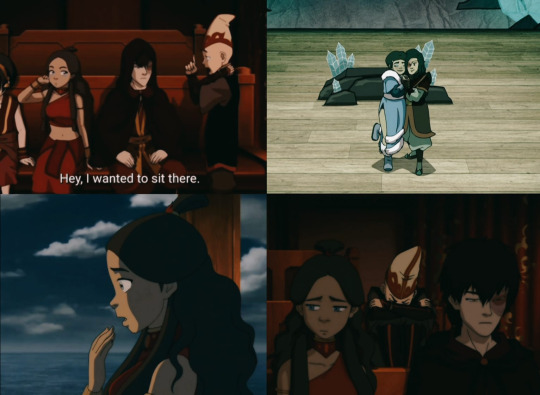
Two approaches to analyzing literature are Doylist and Watsonian: Warsonian is about analyzing from an in-universe perspective, Doylist is about analyzing out-of-universe perspective.
For example: Why did the Gaang arrive at the swamp?
Watsonian: Because a hurricane made them crash.
Doylist: Because the writers wanted to explore the world & characters, foreshadow Toph, introduce plant benders, etc.
This analysis will be from a Doylist perspective. Meaning, I don't intend to prove Katara secretly canonically loved Zuko. She is a fictional character, she'll love whoever the writers want her to love. And the writers said she loved 𝖠𝖺𝗇𝗀. What I do intend to do is to show how the writing alluded to Zuko standing in 𝖠𝖺𝗇𝗀's way to being with Katara.
With that out of the way, let's dive right in!
At the beginning of the episode, when they sit down to watch the play, Zuko and 𝖠𝖺𝗇𝗀 share this exchange:
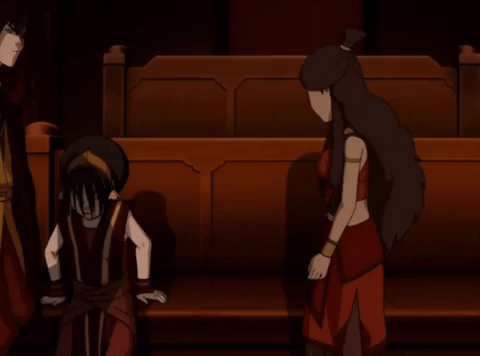

If you didn't catch that, look at Katara:
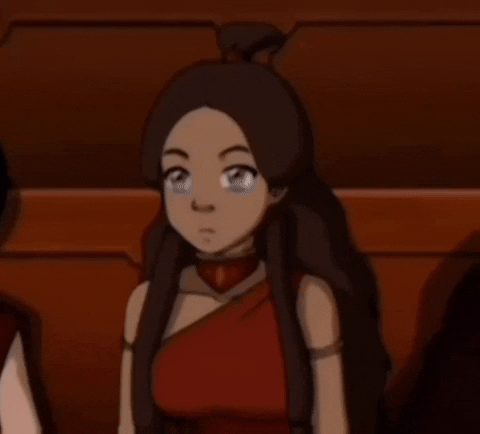
This is a classic romance trope, typically used for female characters, to signify romantic feelings/a crush. But what is it doing here, when Zuko sits next to Katara instead of 𝖠𝖺𝗇𝗀? What is this interaction doing here in the first place?
When an episode aims to explore an aspact of the characters, it will remind the audience of it in the beginning. In The Waterbending Scroll, Katara steals a waterbending scroll and gets insecure about her waterbending. The episode opens with the Katara teaching 𝖠𝖺𝗇𝗀 waterbending and getting insecure. In this instance, they want you to keep in mind the dynamic where... Zuko is in the way of 𝖪𝖺𝗍𝖺𝖺𝗇𝗀? (That's without mentioning what Katara's doing with her hair). That is strange.
Moving on to the play – See the joke about Katara's characterization in the play:
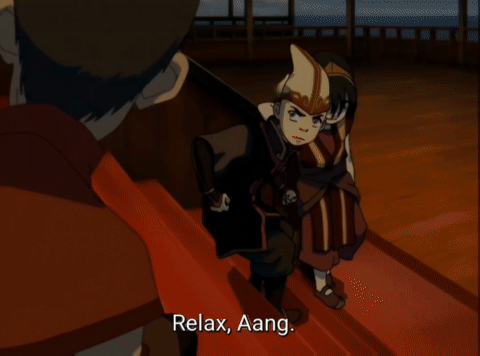
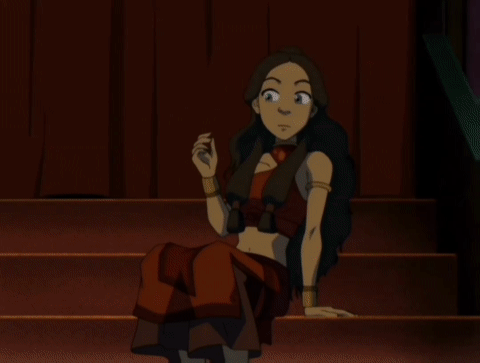
The point of Ember Island Players is while the play is heavily distorted, it is somewhat based on reality. It's funny and even gets under the character's skin sometimes because it shows them a parody of themselves. (Further evidence).
When we get to the the scene between Zuko and Katara in the Crystal Catacombs, for some reason, it's portrayed as some romantic moment.
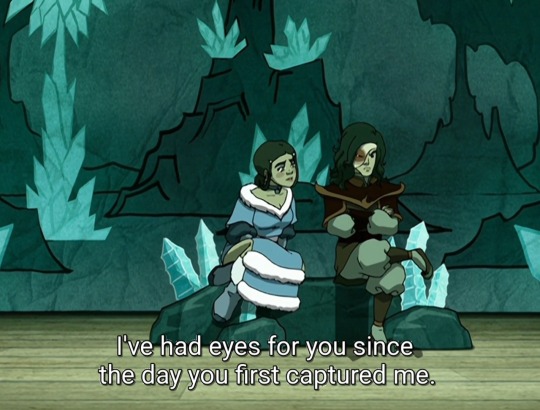
Acknowledging a fan pairing in canon from is always out of the blue/baity from the get-go. I cannot recall a time when another show that did this. Here however, it's under the premise of somewhat founded parody. Which begs the question:

(Side note: There's been debate over Katara and Zuko moving away from each other. It's common for eventual romantic leads to deny attraction. It could be contextualized that way later and audiences aren't trained to rule out the pairing. The meaning is dereminted by the outcome).
Despite that, Katara and Zuko aren't in love. Everyone knows this, right?
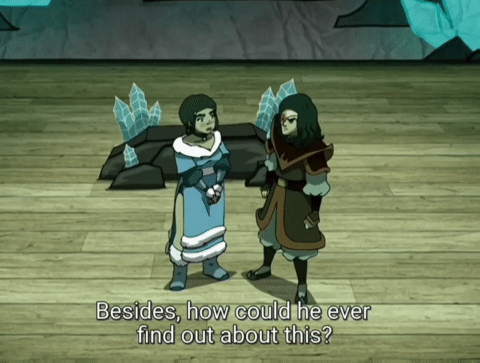
𝖠𝖺𝗇𝗀 is jealous. Jealous to the point where he gets up and leaves the theater. The thing that kicks off the conflict of 𝖪𝖺𝗍𝖺𝖺𝗇𝗀 is... Zutara?
Speaking of the conflict, I won't dwell on it too much, but the events were the following: 𝖠𝖺𝗇𝗀 adressed the kiss they shared in the invasion, a kiss that went unaddressed for 5 episodes. Katara is unable to commit to an answer. Her lines, isolated:
"𝖠𝖺𝗇𝗀, I don't know" // "This isn't the right time" // "Right now, I'm just a little confused".
Until he kisses her once again.
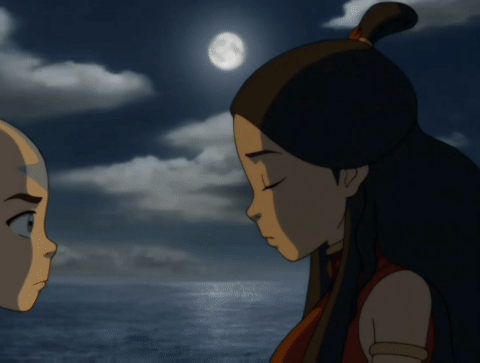
And realistically, she doesn't take it well. Many girls use this language to reject gently. This is purposely written to suggest that they might not end up together. All of which is kicked off because of Zutara. Remember the beginning: Zuko is in the way of 𝖪𝖺𝗍𝖺𝖺𝗇𝗀.
When 𝖠𝖺𝗇𝗀 is back in the theater, he's concerned about his future with Katara. It is showcased with this shot:

𝖠𝖺𝗇𝗀 isn't angry at Zutara here, so why is Zuko in the shot? A director storyboarded this, it was planned. They could have easily leave him out of it and it would convey the message better. Leaving him here implies that he is somehow related to the conflict, That Aang is worried about them, while both of those things aren't true.
𝖠𝖺𝗇𝗀 not being able to sit next to Katara isn't ship baiting. 𝖠𝖺𝗇𝗀 getting angry at actress!Katara not returning his feelings isn't ship baiting. Katara herself being unable to immediately return his feelings isn't ship baiting. What is ship baiting is how all of this is caused by Zuko to a degree.
Zuko stealing 𝖠𝖺𝗇𝗀's seat and Katara giving him a side glance is ship baiting. Zutara being canonically addressed in a play that's vaguely founded is ship baiting. The former causing 𝖠𝖺𝗇𝗀 feeling jealous, leaving, and starting the conflict over it is ship baiting. Zutara is imbedded in the foundations of the episode. Ember Island Players plays out as if there is something between Zuko and Katara, when there isn't. That's ship baiting.
#zutara#the meta everyone has already written#zutara meta#zuko x katara#pro zutara#anti anti zutara#zutara analysis#katara x zuko#zukoxkatara#kataraxzuko#zuko#katara#atla critical#atla critisism#anti bryke#bryke critical#prince zuko#katara of the southern water tribe#zutara evidence#zutara forever#zutara nation#zutarian#zutara was robbed#zutara supremacy
651 notes
·
View notes
Text
I know that when Sokka is training the kids in the first episode of the show, it gets treated as comedy. Particularly when they all ask to use the bathroom. But when you think about it? It's actually disturbing that he even has to do this at all.
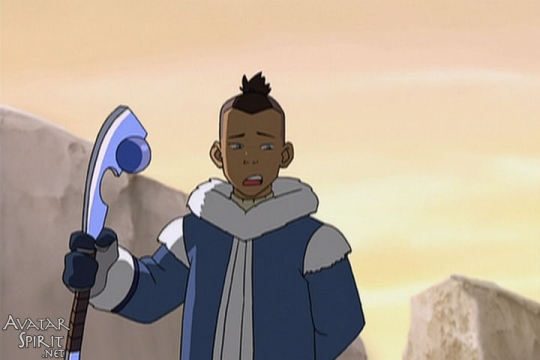

Look at these kids. They can't be no older than 5 or 6. And yet they are being trained for combat. They have absolutely no idea what the horrors of war are truly like. But because of the war, this is their childhood. It's sad.
519 notes
·
View notes
Text
Did The Fire Nation Actually Lose The War?
Well one would assume yes.
At the end of the show Team Avatar defeats the Fire Nation by defeating Fire Lord Ozai and crowning Zuko as the new Fire Lord. Any further details of the Fire Nation defeat are explored through the various comics, with the main topic being the decolonisation of the Fire Nation colonies of the Earth Kingdom.
But if you take a look at how the comics ultimately resolve this issue, it becomes clear that actually the Fire Nation kind of won the 100 Year War.
But didn't the Fire Nation had to decolonise after the war?
Kind of. In the comic "The Promise" it is revealed that the oldest Fire Nation colonies actually become independent and later form the United Republic of Nations. This is because Zuko and Aang decide, that the Fire Nation people and Earth Kingdom people had become too intertwined to belong to either the Earth Kingdom or the Fire Nation.
Now one has to keep in mind, that these colonies belonged to the Earth Kingdom originally before the war. So this decision actually means the Earth Kingdom lost a not insignificant chunk of their country, especially because the colonies are portrayed as quite industrious and wealthy in the comics.
Meanwhile the Fire Nation gained a new allied nation. A lot of the Fire Nation colonists are aligned with the Fire Nation, and this sentiment would therefore also be found in the United Republic of Nations, especially because Fire Nation colonists made up the higher strata of their society.
What about reparations?
Well, the comics don't actually mention reparations. But what we get in the comic "North and South" is the Southern Water Tribe asking the Fire Nation for funds for expanding their economy. Which to me heavily implies that in canon the Fire Nation never actually had to pay reparations, because otherwise the Souther Water Tribe had probably demanded reparations, instead of asking for funds.
This is especially interesting, because investments in poorer, less industrialised nations (like the Southern Water Tribe) can be utilized by richer and more industrialised nations (like the Fire Nation) as another form of imperialism. Either by tying specific requirements, e.g. favourable trade agreements or specific economic policies, to the funds or by using these investments to acquire a lot of economic influence in the nation.
This also means that the Fire Nation economy isn't burdened by paying reparations
Didn't the Fire Nation also suffer under the war?
In comparison to the other nations not really. The Air Nomads got wiped out, the Southern Water Tribe suffered from a cultural genocide, the Northern Water Tribe suffered under the Siege of the North and large swath of the Earth Kingdom were destroyed and its people displaced.
In contrast to that, the Fire Nation didn't even really suffer any civilian casualties or damage to their industrial base. The only attack on the Fire Nation mainland was the Day of the Black Sun, which failed and because the Fire Nation was forewarned didn't result in any civilian casualties. The Fire Nation only really lost soldiers to the war.
But Zuko is Fire Lord now!
Zuko would have become the Fire Lord even if Ozai wouldn't have been defeated, he was the next in line anyway.
And it is nice that he reforms the Fire Nation, but that is not really relevant if we discuss who won the war.
He may have reduced the size of the navy and the army, but it was out of his own volition, not because of some stipulations of a peace treaty. And why wouldn't he? The war is over. The Fire Nation is on good terms with the Southern Water Tribe, the Kyoshi Warriors, who work for Zuko on multiple occasions, and on neutral terms with the Earth Kingdom under King Kuei.
So what is the Score?
The Fire Nation ultimately came out of the war and the peace process with:
A new allied nation in the United Republic of Nations.
Economic influence in the Southern Water Tribe.
Good Relationships with the Southern Water Tribe and the Kyoshi Warriors.
an undamaged industrial base and an economy unburdened by reparations.
losses were mostly limited to military members, with almost no civilian casualties.
Weakened rival nations due to the heavy losses they suffered, which also include a lot of civilian losses.
Wars have been fought for less and have been considered won by achieving less. So in conclusion, if you consider the comics as canon, the Fire Nation came out of the 100 year war as a clear winner. Especially if one considers how much the other nations suffered in the war.
Did the other nations gain anything from the peace process at all?
Yes. They got to live and now have the security that the Fire Nation won't burn them all to the ground. Or at least some of the nations got this security.
#atla#avatar comics#fire nation#earth kingdom#southern water tribe#100 year war#meta#atla meta#united republic of nations
532 notes
·
View notes
Text
I do think there’s an interesting disconnect between how Katara and Sokka on one hand and Jet and his Freedom Fighters view Fire Nation civilians which is best explained by the different policies of imperialism the Fire Nation pursued in the Southern Water Tribe and the Earth Kingdom.
You see, the Fire Nation didn’t see the Southern Water Tribe as occupying desirable economic territory. Their genocidal attacks against the SWT are motivated due to fear of its power and contempt and hatred toward waterbending, but the Fire Nation has no interest in territorially occuppying the Antarctic, made particularly care by the fact they seem to lose most of their interest once the power of the SWT has been “broken.” As a result, there is no policy of occupation or building permanent settlements, while the campaigns themselves are almost solely carried out by uniformed soldiers and sailors. Fire Nation civilians are critical to the campaigns through their support for the war effort, but the SWT victims of the Fire Nation’s raids almost never see them, instead almost solely being exposed to soldiers and sailors. As a result, Katara and Sokka regard Fire Nation soldiers to be intensely threatening, but don’t regard Fire Nation civilians to be threats and are often even sympathetic to them. They make no commentary on the Fire Nation policies of settler-colonialism when they encounter them in the Earth Kingdom.
By contrast, the Fire Nation is intensely interested in the Earth Kingdom’s land and resources. It pursues a policy of settler-colonialism there, aiming to exert imperial control while seizing land and resources. “Civilian” settlers are a tool and weapon of imperial control and domination, critical for establishing power. Thus, Jet and his friends, as victims of settler-colonialism, perceive Fire Nation civilians as intensively threatening and as engaging in acts of aggression through their mere presence.
Thoughts? It all makes me feel like we really needed to have Jet join the Gaang.
#Katara#Sokka#Jet#Jet meta#Sokka meta#Katara meta#fire imperialism#southern water tribe#water siblings#water tribe#Earth Kingdom#settler colonialism#ATLA#Avatar The Last Airbender
389 notes
·
View notes
Text
AFTER LONG FREAKIN LAST
I am ecstatic to announce...

CHAPTER 17

In which Zuko fades in and out of consciousness, the crew faces a tough inquisition, and bigger and badder plots begin to germinate
13 notes
·
View notes
Text
AtLA Analysis: S1E1: The Boy in the Iceberg
Intro: I’ve decided to rewatch AtLA again, and this time I’m analyzing/writing down my reactions to it as I go. I’m a huge fan of villains (if you couldn’t tell) so this series will likely focus on antagonistic characters and on random details I catch especially about the Fire Nation. However, I will be making an effort to pay attention to characters and parts of the show that I haven’t paid much attention to before. Hopefully I’ll be able to get this done before Fall classes start, so if all goes well it’ll be one or two episodes a day. On the other hand, work is a thing, so that may be an unrealistic expectation. Perhaps instead you should expect a couple of episode analyses on weekends.
Now: on to the show, and on to the analysis!
Oh, it’s been a while! The introduction to the first episode is a little bit different from what I remember of the regular introduction, with Katara saying “My grandmother used to tell me stories about the Avatar...” instead of “Long ago, the Avatar...” after the first line of “Water. Earth. Fire. Air.” I think that’s a nod to where Katara’s character is at the very start of the season, not knowing that the Avatar exists and has been cryogenically frozen for the past hundred years.
She also calls the invading force “the ruthless firebenders,” as if each individual in the population was at fault rather than the governmental system. Points to in-universe prejudice and inter-ethnic tension, perhaps? Or is it Katara’s lack of understanding of population dynamics and government on a large scale, growing up in the small Southern Tribe? Or is it both?
The different first monologue also gives us pieces of crucial information: “The Fire Nation is nearing victory,” and “2 years ago, my father and the men of my tribe left to battle the Fire Nation.” The shot associated with the second line shows a mere four small (?) boats, each holding who knows how many men--but not that many, not enough. This implies that the Fire Nation is everywhere, and most of the fighting going on is between not fellow armies from different nations but FN garrisons and pockets of resistance. No wonder a 17-year-old boy is leading the Freedom Fighters.
She says, in the first monologue, that she has hope that the Avatar will return to save them. This seems naive to me, placing faith in a legend, but she is 14, and struggling to survive in a broken community. All we see of the Southern Tribe is Katara and Sokka’s small village. Are there other fragments of a once-great civilization out there, struggling to survive, or is what we see truly all that’s left? The tragedy of the Southern Tribe is left mostly untold, at least until Hama, but we can see its effects in the very first episode.
We open, of course, with Sokka and Katara attempting to catch fish. Sokka is overconfident and boisterous, bragging to his sister: “This is how you catch a fish.” We also see Katara waterbend, though we get the sense that she isn’t totally a master of the art yet--once Sokka bursts her bubble she has no reflex to keep the water in the air and the fish out of the sea.
We also get Sokka’s line “Why is it that every time you play with magic water, I get soaked?!” and Katara’s exasperated “It’s not magic, it’s waterbending.” A funny exchange, at least on the surface, but further analysis and its placement in context just drives home the tragedy of the Southern tribe’s lost culture. Waterbending is crucial to its culture and its survival, and Sokka can’t even remember the name. Even if he was stubbornly refusing to listen to the stories of his tribe, waterbending should be so suffused into the social environment it would be impossible for him to not know what it is, and he certainly shouldn’t be calling it weird. His referring to Katara’s ‘hair loopies’ as, well, ‘hair loopies’ is another piece of evidence for this. Even with his (admittedly perfectly normal) teenage-boy I’m-invincible-and-know-everything attitude, he should still know more about his culture than he does.
Damn, not even 3 minutes in and I’ve already got a rant on the decline and tragedy of the Southern Tribe. But! On with the show!
Next we see another piece of evidence for Katara’s lack of skill with waterbending: they get caught in a current between dangerous ice floes. If she had had the skill, likely she would have used her waterbending to lift the canoe over the ice and to a safer spot, or to push the ice floes away. Instead, because she is a 14-year-old girl with a power she doesn’t understand and no teacher to guide her, she doesn’t do much but panic and backseat drive. Shouting at your siblings to ‘go left! GO LEFT!’ is peak sibling dynamic, trust me.
Once their canoe is destroyed (how much and what gear was in that canoe and is now lost?) and they get stranded on the ice floe, we get the first blatant look at Sokka’s misogyny: “Leave it to a girl to screw things up!” He says this despite the fact that he’s been living with only women and children for two years now. (The first hint may have been more subtle, with his dig at waterbending, if it was considered a more feminine art in the South, but that would likely be better explored in The Puppetmaster.) This might have several factors behind it: Hakoda’s charge to Sokka to be the ‘man of the tribe’ when he left, for one, which implies a lot about gender dynamics in the SWT.
And then, of course, we get Katara going off (queen shit) at Sokka, calling him out for his sexism (which seems to imply that maybe Sokka’s attitude towards gender roles isn’t actually traditional or expected?). She also says “I’ve been doing all the work around camp while you’ve been off playing soldier!” which, while it probably has some merit to it, mostly implies that these siblings don’t appreciate the work the other does. It implies a lack of respect between the two as well as Sokka’s unhelpfulness. Which, ykno, pretty normal (if not entirely healthy) sibling dynamics, at least to me. (Same with the ultimately empty ultimatum she gives him while accidentally waterbending open an entire iceberg.)
Also, the faces during that whole exchange are fucking hilarious.
IT APPEARS! Who knows how much Spirit Shit these two have seen. From their reactions, I’m gathering two possibilities: a) this is entirely new to them and they have no idea what’s going on, or b) they have some idea of what’s going on but they think it’s highly dangerous. Neither of which points to the flourishing of stories and spirit tales in the SWT.
Sokka’s line “We don’t know what that thing is!” cements the first possibility. It also shows the difference between his cautiousness and Katara’s immediate want to help (“He’s alive!”). They serve as foils to each other right from the beginning.
If I had to pick an inciting incident here, it would likely be when Zuko lands his ship at the SWT and demands the Avatar, although this would be a close runner up. Aang’s waking up is a natural starting point for the way that he changes the course of the world.
What exactly caused that fierce wind and that pillar of light? The wind probably points to high air pressure inside the ice, but if it was an air pocket, then how did Aang survive? And why was he suspended in the ice ball like that? The pillar of light, on the other hand, was definitely Spirit Shit.
Aaand there’s Zuko! The first look we see on his face is amazement, almost disbelief. Did he truly have so little hope in his quest? Of course, it quickly changes to an angry determination. He has a reputation to keep up (and he’s a dramatic theater nerd). But that subtle show of his softer, less angry side right at the start hints at the character arc to come.
Iroh sounds tired in that first conversation: “I won’t get to finish my game?” “Or it’s just the celestial lights!” He’s clearly somewhat disillusioned at this point with Zuko’s quest, or just tired of his nephew’s antics. It seems almost strange, given the light the show later puts him in.
Zuko’s line “That light came from an incredibly powerful source! It has to be him!” tells me two things: number one, that everyone seems to assume that the Avatar is going to be a man (sexism in universe, or out-of-universe lazy writing with a male Avatar character already picked out?). It feels odd. Avatar Kyoshi wasn’t that long ago, and Zuko as a Prince should be well-versed in history, no? Number two, it tells me that Zuko is probably far more experienced with Spirit Shit than Sokka and Katara are. Makes perfect sense, given how he’s been desperately chasing a legend for three years.
“I DON’T NEED ANY CALMING TEA! I need to capture the Avatar!” 1. Further cements Zuko’s hotheadedness. 2. Gives us information on what his goal is and how desperate he is to achieve it.
When we cut back to Sokka and Katara, we see Sokka shielding his sister. He’s protective of her, and she lets him protect her. Clearly, they love each other, despite their earlier bickering.
Aang’s wake-up scene: Sokka poking Aang’s head (cautiousness and nervousness) vs Katara cradling him (kindness), “Will you go penguin-sledding with me?” showing off Aang’s playful side right at the start.
Appa’s friendly nature and relationship with Aang is established right off the bat: licking Aang, Aang’s gleeful “You’re okay!”
What’s sticking out to me most is Katara’s trusting nature vs Sokka’s cautiousness, at least when it comes to Aang. Katara’s in the right here, of course, but she won’t be about everyone. Jet comes to mind, as does Hama. Sokka and Katara balance each other out. I probably won’t be making such close note of that side of them--I feel it’s established by now, and I don’t want to take four hours to watch a 22 minute episode.
Sokka uses ‘feet’ as a measurement device. What’s the story behind that? Just a lack of worldbuilding, or is ‘feet’ an actual in-universe measurement? How big is it? Whose feet are they going off of?
Sokka is also practical: despite his reservations about Appa, he doesn’t refuse to get on and let it and Aang give him a lift. Although he’s clearly not happy about it. He also seems to be sarcastic when he’s in a bad mood. He is, after all, the Meat and Sarcasm Guy.
Holy shit, Iroh just straight up tells Zuko he won’t find the Avatar. I mean, I get that this is the first episode, and we have to establish history and stuff, but like--ouch. Definitely doesn’t fit with the ‘kind old mentor’ character so many see him as. It seems as if Iroh doesn’t have much of a character at this point, and he’s just being used as exposition. I’m of the opinion that Iroh’s character and development is one of AtLA’s weak points, and so are many of my friends, but I might be in a sort of echo chamber. Which is part of the reason I’m doing this rewatch. Also: He straight out says that Ozai, Azulon, and Sozin all went looking for the Avatar as well. You heard it here, folks! Ozai did leave the Fire Nation for at least one point in his life!
Zuko then goes on to say why he’s different: his honor hinges on the Avatar’s capture. He doesn’t outright say ‘banished’ here, though, which is...interesting. It implies almost that he could go home if he wanted to, he’d just go home in shame and he’s just really concerned about reputation. In context it makes sense, but it gives off almost the wrong impression about Zuko’s situation. Although I would make an argument as for Zuko’s shifting definition of honor, from external reputational ‘honor’ to internal moral ‘honor,’ over the course of the series, and therefore this line would give off exactly the right impression for his character at that point in time.
I forgot to mention that first hint of Kataang: “why are you smiling at me like that?” “I was smiling?” (At least, I think it’s a hint of Kataang. I’m aroace, I’m oblivious to these things.)
Aang says that he didn’t know the Avatar when Katara asks. It’s obviously a ruse, but perhaps it might be poetic, if you could argue that at this point Aang doesn’t know himself.
So far, Aang comes across as fun-loving, happy-go-lucky, and sweet. However, with context, that ruse also paints him as a little bit untrustworthy, a little bit avoidant of responsibility. Almost like he embodies the element of Air itself. However, he clearly feels apprehensive about it, from his expression after Katara turns away.
How far were Katara and Sokka from camp when they found Aang? How long does it take to reach the village, give that Aang wakes up there? Is Appa even going in the right direction at first?
The dream Aang has doesn’t give us a lot of information at first. It looks almost as if he’s been possessed (and technically, he kind of is possessed by the Avatar State) after falling prey to the storm. But it does give us a hint that he’s more than he seems, even after watching him emerge from the glowing ice ball.
Katara sees Aang’s tattoos and realizes something--but what? That he’s an Air Nomad? We’ve already established that he’s an airbender. Having to realize on top of that that he’s an Air Nomad implies that there were airbenders outside of the Nomads, and they were well-known enough for Katara to hear of them. However, Gran’s statement “No one has seen an airbender for a hundred years” implies that those airbenders may have been wiped out too.
I already said much on the topic of the SWT dying, but the sheer tininess of the population really drives it home. Also, there are a lot of very young children, although I’m guessing no one under the age of 2 here. What happened to produce so many children at that point in time, and almost none who are Katara or Sokka’s age?
In the shot of ‘the entire village,’ I counted 19 and a dog. Add Katara and Sokka, and that makes 21 and a dog. Katara and Sokka are the only teenagers there. Gran Gran is one of two older women there. There are seven non-elderly adults, all women. Ages of children are hard to guess due to lack of detail, but I count four older children (two boys, two girls) and six younger children (three boys, three girls). Ages are skewed younger for both children and adults. Was this deliberate, coincidental, or influenced by outside environmental factors? If there were other boys Sokka’s age, and they went with the adult men, then why was Sokka left behind? It doesn’t seem likely--there aren’t any girls Katara’s age either. How many men were on those boats? How many women joined them? Who’s missing from this picture?
I’m surprised Aang’s upbeat enough to banter with Sokka and show off his flying skills after Gran Gran said that she and the SWT, if not the world, thought that airbenders were extinct. Perhaps he’s just in denial. That would make sense for his character at this point in time, as does him crashing into the watchtower from not looking where he’s going.
The watchtower is Sokka’s, which implies that he built it. That means he’s planned out and finished a medium-to-long-term project already, one that was made in the interest of protecting the village, which is more than the ‘playing soldier’ Katara accused him of. He’s been working towards the goal that his father set him, which is to protect the village.
Katara says she’s not yet a waterbender, despite her ability. Does the label ‘waterbender’ only apply to those who have mastered the art? Hell, the way they talk about it, it’s almost as if anyone could learn to do it.
“I sense he’s filled with much wisdom.” Is he, Katara? Is he? Or do you just have a crush?
Iroh is hard on Zuko during the firebending training scene, with a callous demand to “get it right this time” after explaining the fire-from-breath philosophy. The sequence itself, despite Iroh’s claim that Zuko hasn’t moved past the basics, looks pretty advanced, pairing acrobatics with fighting against two opponents. Zuko also demonstrates a lot of raw power, firebending at one of his opponents and actually knocking them backwards. Zuko worries about the Avatar’s bending prowess and uses it to order Iroh to teach him the advanced set, though Iroh doesn’t look happy about it. He actively uses his roast duck to hold off on obeying that order, knowing it would annoy Zuko. Zuko looks almost disgusted when he pulls it out. (I agree--where has that been?)
Sokka gives his speech about courage and facing a firebender to six boys, all of whom look the same age, maybe three or four. While there are six male children in the ‘entire village’ shot, they don’t look all the same age in that shot like they do in this. What are their ages? Why are there so many young children and so few teenagers?
In the shot where they’re all walking away, they no longer look the same age. The oldest, however, I’d peg at about seven years old, still much younger than Sokka and Katara. The age distribution of this village is bugging me.
Aang’s comment “Everything freezes in there!” seems off to me. Yes, it’s made of snow, but that snow should still be insulating heat, no? Also, what is that pipe made of snowbrick? It looks well made, better than Sokka’s watchtower. Is it part of Sokka’s watchtower or something else? What is its purpose?
Aang hears about a war, worries, and then is immediately distracted by the penguin. Add distractable to the list of attributes for early-show Aang. It’s also a clear avoidance of the darker things in life.
Despite Katara calling herself ‘not really’ a waterbender before, she tells Aang during the penguin sequence that he’s looking at ‘the only waterbender in the whole South Pole.’ An odd contradiction. Also, we see little evidence that there are any other villages in the South Pole, and yet it seems implausible that Katara and Sokka’s is the only one, or even the only one left. Perhaps the Fire Nation has been slaughtering them one village at a time. But if so, then why would the men leave the women and children?
Aang is also helpful, kind, and optimistic, much like Katara. He offers to fly her across the world to the North Pole to help her find a master as soon as he hears that there’s no one who can teach her in the SWT. Although, as the Avatar, he may have had an ulterior motive there.
During the sledding scene: Katara: “I haven’t done this since I was a kid!” Aang: “You still are a kid!” It’s delivered in a fun setting, in a lighthearted manner, but here lies one of the biggest driving factors of AtLA: the cast are children. Children growing up too quickly in a world torn apart by war. Children taking on adult responsibilities because there aren’t enough adults. Fun gets left by the wayside in the face of fear and pain and responsibility. And Aang wants to bring back fun.
The penguins don’t seem too bothered from being used as sleds. Do they ever get back to their flock, I wonder?
“If you want to be a bender, you have to let go of fear,” Aang says. Granted, it’s in getting Katara to do something stupid, but how much of this philosophy is real? Air is about fun and spirituality; Water is about change and adaptation; Earth is about stability and strength; Fire is about passion and life. Fear gets in the way of all of this.
I’m picking apart every detail I notice. And yes, it’s taking me four hours to watch a 22 minute episode.
Everything about the beached ship is presented as dangerous, dark, and sinister. Even the ripped banner of the Fire Nation, with its black-on-red symbol, seems an omen of terrible things. It’s military, cold, cruel, and dangerous. Even if I like the Fire Nation, I can’t say I don’t like the atmosphere, and at this point in the series it’s perfectly understandable to paint the Fire Nation as this constant, background, oppressive threat.
Okay, so: the ship has ‘haunted [Katara’s] tribe since Gran Gran was a little girl.’ How old is that ship? Why didn’t that booby-trap thread decay? Was it because it was cold? Seriously, how is that booby trap still working? We see Hama help to beach it later in the series, which places Hama as older than Gran Gran by a bit--is Gran Gran younger than she looks, with the stress of the war and being matriarch prematurely aging her? If so, then how old is Hakoda or Kya or whichever Gran Gran’s child is? Is she actually Katara and Sokka’s biological grandmother? What does that mean for marriage customs and family culture in the SWT?
Also: did that flare bust through the roof? Was there supposed to be an opening there?
Zuko calling Aang ‘agile for his old age’ is hilarious. And then we get the first hint that Aang really is the Avatar, with Zuko straight up saying that he’s the Avatar. Of course, if you’re a first time watcher and don’t know anything, then you have no idea if he’s even correct (unless you look at the title). Calling the SWT his ‘hiding place’ does not bode well for the village, but we all know that.
And that’s the end of the first episode! Looks like it only took me three hours. In my defense, I was trying to take care of other things at the same time. Also, I would rather not have later analyses be this long, but at the same time I have a tendency to immediately write down Thoughts(TM) on every single detail that grabs my eye, so who knows.
#atla#avatar: the last airbender#s1e1 the boy in the iceberg#katara#atla katara#sokka#atla sokka#southern water tribe#atla analysis#atla meta#cw swearing#zuko#atla zuko#iroh#atla iroh#aang#atla aang#long post#like really long post
37 notes
·
View notes
Text
ana's meta masterlist
Pro-Zutara:
the official zutara dissertation: part 1 | part 2
zuko, aang and taking lightning for katara
zutara and romantic coding
"you rise with the moon, i rise with the sun" is a zutara line
zutara and thematic significance
zutara vs jetara
zutara parallels in the awakening
zutara's narrative culmination
zutara in the crossroads of destiny:
azula vs katara
love as resistance in the catacombs
zutara in the southern raiders:
the true source of katara's anger at zuko
katara bloodbending before zuko
the narrative relevance of zutara
zutara and bloodbending
zutara's narrative symmetry
why zuko had to betray katara in ba sing se
Anti Anti-Zutara:
the official zutara dissertation (p.3)
"zutara would face too much opposition from their countries"
"zuko and katara are a colonizer/colonized ship"
"zuko and katara would fight all the time”
"platonic zutara is better than romantic zutara"
"fire lady katara is racist"
“zuko would’ve taken lightning for anyone”
“katara is too traumatized by the fire nation”
ATLA Ship Criticism:
the official zutara dissertation: part 4 | part 5 | part 6
why mai.ko was never intended to be canon
mailee is a better ship than mai.ko
how kat.aang could've been fixed
kat.aang's lack of trust in the southern raiders
emotional labour in kat.aang
kat.aang’s narrative imbalance
comparing katara and aang's parenting
why the fortuneteller does not foreshadow kat.aang
ATLA/LOK:
azula/katara parallels
katara's choice in the crossroads of destiny
was zuko's betrayal in-character?
zuko's comments in the southern raiders
zuko's comments in the southern raiders (pt. 2)
zuko is not a “bad boy”
sokka didn't feel inferior to katara
did mai fear azula?
comparing mai and toph
sexism in the water tribes
thoughts on the atla comics
gratuitous violence in the legend of korra
The Hunger Games:
zutara and everlark parallels
zutara and everlark parallels (pt. 2)
gale's arc in the hunger games trilogy
the myth of humanity's inherent evil
the ending of lucy gray
Squid Game:
individualism under capitalism
the ethics of billionaires
#zutara#anti kataang#anti maiko#zutara meta#been intending to do this forever but i'm on this hellsite so much that going through my archives took an eternity lmao#anyway here's a collection of patented ana rambles
526 notes
·
View notes
Note
Hi, I’m finding it difficult to wrap my head around your (and some other meta writers) take on Sokka’s sexism and how writing a nonsexist society would be braver?
Why is it more brave to write a story without bigotry than one overcoming it?
Defensive Writing Section Where I Respond to What I Imagine You Could Respond With: 1) I know the original series did not succeed in, or even really try, empowering its women. 2) I know sexism is baked into the show and its romances. 3) I know Katara deserves better (but, this might be where we diverge, I don’t feel served by a reality/story where we pretend women’s domestic, unappreciated labor isn’t a pillar holding society up. Tbh it feels kinda disrespectful to keep that offscreen and media tends to downplay it as is). 4) I know the show isn’t out yet and we’re all guessing. I am picking your brain on your guess cause it confused me. 5.) Sokka’s arc is about maturing manhood and leadership, I’m afraid removing his sexism dodges an opportunity to explicitly deconstruct its toxic expressions. Again, I know the show was unsatisfactory with this the first go around.
Fan Mail Section Where I Attempt To Convey I Meant No Harm: Love your blog! Again, just confused.
First of all, I did not say that writing a nonsexist society would be braver or that the story should not have bigotry in it. What I said is that the story should have more adult women in it.
For example, I do enjoy Katara's story of struggling against feeling like she needs to take on a motherly role because of her gender. I think it's realistic because it's a conflict many girls face, and watching her fight against that can be cathartic. But what's harder to reconcile is the way the narrative goes out of its way to justify forcing this role on Katara. Not all of this can be chalked up to a sexist world. Kya being dead before the story begins was a decision the writers made, for example. I'm not necessarily saying that should be changed, but it is a common trope in media and it's a problem that women are disproportionately killed off to serve fictional narratives this way. Compare, for example, the way the story explains Hakoda's absence without killing him off entirely, and the fact that we know a heck of a lot more about him as a character than we do Kya. His absence is still used to characterize the heroes, to explain the struggle they face in a war-torn world, but he gets to be an active agent in the story, too.
Another example is that although a lot of Sokka's sexism stems from a lack of understanding of Katara's waterbending, which can be explained in the narrative by the fact that the FN has nearly eradicated southern waterbending, this does not explain why Katara wasn't taught more about her bending by her grandmother, who is both from the northern tribe and present when Hama and the other benders were taken. In the flashbacks in "The Puppet Master," we see that there were many women who used combat waterbending, and apparently waterbending healing was not even known in the south so there was no gendered division like in the north. There's no real reason why that should change so quickly in such a short amount of time to the point where the southern water tribe all of the sudden becomes this hugely sexist society where only men are known to fight.
Katara and Sokka are presented with opposite ideas about gender, but we don't have any real sense of where they got these ideas. I like to headcanon that Katara got her feminism from gran-gran, who fled the southern water tribe because of sexism, but it's strange then that Katara doesn't even know this story. Why is Kanna such a complete nonentity in the narrative, when her story is so important to the story the show wants to tell about Katara?
We get more backstory on Sozin than we do a lot of the adult women in the story, when they even show up. Zuko's mom is fridged just like Katara's, and although I love how this serves as a bonding point between them, it would be less glaring if Iroh's and Azulon's and Sozin's wives were also not nonentities in the narrative.
Someone commented on this post that the live action might be giving us Suki's mom. So let's look at how even this small change might effect the story. Even keeping in Sokka's sexism. Let's say that it does play out like in the original, and when they get to Kyoshi Island, Sokka is shocked - shocked! - to be beaten by a bunch of women. We're supposed to think Sokka is wrong. And he does get proven wrong. But the Kyoshi Warriors are still the exception to the rule. Sokka doesn't so much learn that women deserve respect as much as he learns to respect some women because they can kick his ass.
But, if we bring in Suki's mom, then suddenly Suki doesn't have to be the sole named character responsible for teaching Sokka not to be sexist. The story becomes less about how Sokka should respect women because some of them are cool and he'll get a girlfriend out of it, and more about how all women deserve the same respect, because we see more women just present and living in the world of the story.
I'd also like to ask everyone to take a step back here, because to my knowledge, the show never said it was taking out certain arcs or presenting the characters without narrative flaws. This all seems to stem from the young actors themselves saying merely that the show took out some "iffy" moments.
So what did they take out that Ian and Kiiawntio might be referring to? Maybe some of the anachronistic and, frankly, racist moments such as, for example, Sokka and Katara calling Zuko and Sokka's cultural hairstyles "ponytails." Which would make sense, considering that the show probably feels like they can trust their audience to accept hairstyles that might appear different to Americans moreso than the writers of the original show did, considering that this is not a show airing on American kids' cable in the early 2000s, but a modern show with a global and much more globally aware audience. These are the kinds of updates that I would expect from a modern live action series. And that is a very good thing.
I also trust the young actors of color playing these kids to say "hey, these kids would not actually talk like that!" More than I trust white writers and execs.
53 notes
·
View notes
Note
Every time I see zutara shippers using a certain line from “The Painted Lady” as a proof that Katara would totally stay in the Fire Nation I can’t help but imagine this cringey scene:
Katara: I will never, ever turn my back on people who need me!
The whole Southern Water Tribe *desperately needs Katara, the only southern waterbender*
Katara: No, not you.
The cringiest part are zutara shippers who think that this is totally IC Katara.
Yup. They always take that line as somehow meaning Katara developed some kind of strong kinship with the Fire Nation (and by extension Zuko), when it is CLEARLY just about her role as a freaking war hero and HEALER! Of course she doesn't want to turn her back on a bunch of people that are being forced to choose between starving or eating food that will make them sick. Doesn't mean she wants to live in their village/nation.
It says a lot about Zutarians that nearly all of their "understanding" of Katara's character consists of either ignoring or deliberately misterpreting everything about her and her arc. It's no wonder their fanfics and metas always have her being widly out of character.
Also Katara wanting to help ANYONE who needs her, even if they're not from her tribe, even if they're from a nation that brought her so much grief, makes her a PERFECT match for the freaking Avatar who also happened to be raised by NOMADS!
Both Katara and Aang want to help people, like traveling the world, AND want a place to call home where they can be with their loved ones. Of course she's with him instead of the guy whose main duty is to ONE nation alone - the nation she has the biggest disconnect from.
41 notes
·
View notes
Text
The Cycle Repeats: Part IV
One of the key themes of the ATLA franchise is the concept of the Avatar; master of all 4 elements, the fusion of humanity and Raava, the spirit of light and order, whose sole duty is to bring balance to the world, and be the bridge between both the physical and spiritual realms. Along with this comes the idea of reincarnation, which is the premise of the Avatar Cycle, the idea that the Avatar reincarnates in a cyclic order in any of the four nations (fire, air, water, earth). Another concept related to the Avatar Cycle (although originating from the fandom) is the idea of the Avatar fixing the mistakes of their past life, which is often indicated in differences in both habitual circumstances and personalities between both predecessor and successor, and therefore differences in morality.
But what if I were to tell you that the saying "history repeats itself" is also true among Avatar incarnations? Not exactly going the same way, but rather parallels between the lives, personalities, and accomplishments (and failures) of past lives?
In this series of metas, I will be going over parallels (or in some cases, foils) between certain pairs of Avatars that lived decades, or even centuries apart, and yet could not have ever been more similar.
An Unlikely Analogy II: Avatars Kyoshi and Korra (+ Yun)
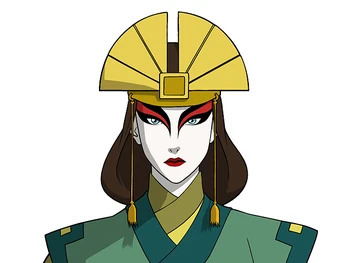
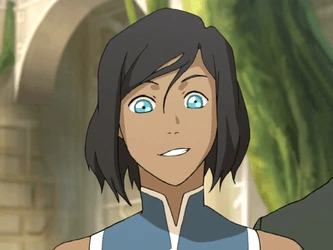
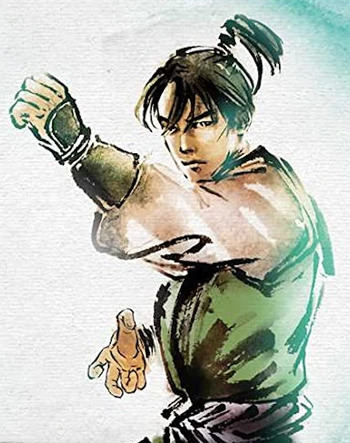
"Kyoshi was the Earth Kingdom-born Avatar immediately succeeding Avatar Kuruk of the Northern Water Tribe, and preceding Avatar Roku of the Fire Nation. She died at the age of 230, making her the oldest confirmed human, and was also an exceptionally tall woman, towering over most people. Kyoshi was born to two criminals: Jesa, a renegade Air Nomad nun, and Hark, a thief from an impoverished family of Earth Kingdom actors. She inherited her later signature outfit from her parents, adopting her mother's golden headdress and metal war fans and her father's daofei face paint."
"Korra is the current incarnation of the Avatar and immediate successor of Avatar Aang. Born and raised in the Southern Water Tribe, where she mastered waterbending, earthbending, and firebending, she later relocated to Republic City to attain a similar proficiency with airbending under the tutelage and guidance of Tenzin, as well as to help her overcome her aversion to the spiritual aspects of the bending arts. With the assistance of Aang's spirit, Korra gained the ability to energybend and, after connecting with her past lives, she gained the capacity to enter the Avatar State at will, marking her transition into a fully realized Avatar."
"Yun was the friend of Kyoshi and Rangi and the earthbending pupil of Jianzhu. Talented, charismatic, and handsome, he was misidentified as the new Earth Avatar after a long and difficult search. Following the revelation of Kyoshi's identity as the true Avatar, Yun was betrayed by Jianzhu, who felt the boy's usefulness had been exhausted and allowed Father Glowworm to carry him off in the mountains."
I once again posted the first paragraph of their respective pages, and you might be wondering why I've included Yun. The reason is that, although Yun was misidentified as the Avatar, he still has various parallels with both Korra and Kyoshi during his "journey". On the surface, you might say that they are more balanced; they have both similarities and differences between their morals and personalities. You would be right on this account, so let's dive in!
(WARNING: There will be possible spoilers for both The Rise of Kyoshi and The Shadow of Kyoshi. If you do not wish to be spoiled, I suggest not reading any further and scrolling past this post until you have finished reading both novels. You have been warned.)
First, we have to take account the parallels between Kyoshi and Korra. The problems that arose during their times were rather complex; Kyoshi's predecessor Kuruk left behind a destabilised Earth Kingdom overrun by criminals, while Aang, although he brought the world to peace, had left behind both the Equalists and the Red Lotus for Korra to deal with. In addition, according to the first chapter of both The Rise of Kyoshi and the premier of The Legend of Korra, Welcome to Republic City (Book 1: Episode 1), both Jianzhu and the White Lotus had been looking for the Avatar for years. Jianzhu and Kelsang had been trying to locate the Avatar across the Earth Kingdom, while the White Lotus had searched both the North and South Poles. This is also where Yun comes in.
Initially in Book 1, Korra had similar opinions on violence and control as Kyoshi did (only justice will bring peace), and even befriended a polar bear-dog (Naga) at the age of four. (Polar bear-dogs are considered to be dangerous animals in the Avatarverse.) However, there is a difference between how each Avatar reacted to her status. Kyoshi denied it and ran away (which I have mentioned parallels with Aang), whereas Korra was the one who discovered her status and accepted her fate as the Avatar, saying that there was nothing more she wanted to be, which is a parallel to Yun's false identity as the Avatar. Ironically, Kyoshi (like Aang) ran away from her duties when the world needed the Avatar, while Korra accepted her duties during a time when the world had long since advanced beyond the need of an Avatar.
Both Kyoshi and Korra are also of mixed ancestry; Kyoshi's father was from the Earth Kingdom, while her mother was a rogue Air Nomad. Korra's father, like Kyoshi's mother, was a rogue immigrant to another nation, being a member of the NWT royal family, while her mother was from the SWT, which gained independence from the North after the Water Tribe Civil War. Kyoshi and Korra are also the only two Avatars to master the elements in their home nation, rather than travelling abroad (Kyoshi learned earth-, fire-, and waterbending with the FOC in the Earth Kingdom and mastered air- and waterbending in the Fire Nation, while Korra mastered water-, earth, and fire-bending in the White Lotus Compound in the South Pole and learned airbending at Air Temple Island in Republic City). However, Kyoshi was constantly on the run, living on the streets as a child, whereas Korra lived in comfort, but isolation.
However, their bending affinity are opposites. Kyoshi struggled to earthbend due to her sheer power, to the point that she had trouble bending small amounts of earth, while moving chunks of the seafloor with ease (not how it typically works), and favoring its elemental opposite, air, in combat. Korra, on the other hand, preferred earth- and especially firebending in combat, while struggling to airbend due to its philosophies contradicting with her drive and hot-headedness.
Now, the parallel between Korra and Yun. Korra and Yun's respective upbringings parallel each other; both grew up isolated in compounds, and being taught by the companions of their predecessors, being told that the only thing that mattered was their status as the Avatar. As a result, this caused a serious mental stunt for both of them, especially when it was revealed that Yun wasn't the true Avatar. Korra wasn't taught how to properly handle politics, whereas Yun went all-in and hunted Kyoshi down Tai Lung-style. Ironically, this was originally supposed to be a way to protect the Avatar, issued by their predecessors, Aang and Kuruk respectively, which was apparently misinterpreted by their supposed caretakers (The White Lotus and Kuruk's companions respectively).
Finally, the parallels between Kyoshi and Yun. Both are similar in that they both grew up abandoned in the streets; Kyoshi in Yokoya, and Yun in Makapu; at least until they were moved into Jianzhu's mansion in Yokoya. Both were "cared" for by a former companion of Avatar Kuruk (Kelsang and Jianzhu respectively; note that I put quotation marks on "cared for" because Jianzhu pretty much physically and mentally abused Yun), but this is where the similarities end.
Now, there are a handful of scenes in the Kyoshi novels which particularly stood out to me. The parallels between Yun's ability to bend the tiniest speck of dust vs Kyoshi struggling with the finer movements but easily raising the entire sea floor during her fight with Tagaka. The parallels between Kyoshi almost drowning herself to connect with Kuruk for the first time while forgetting she can waterbend vs Yun returning to the physical world only to be denied access to water.
We have to remember that the element of earth plays a central role in Rise; Kyoshi is a born earthbender, the book takes place in the Earth Kingdom, earth is the only element Yun can bend, earthbending is the only advantage Jianzhu has against Kyoshi, most of the FOC (Kyoshi's daofei gang) are earthbenders,etc, while the element of water is a central theme in Shadow (which is ironic, considering the book takes place in the Fire Nation), as is Avatar Kuruk's legacy as the Water Tribe predecessor of Kyoshi. In the original series, Iroh states that water is the element of change. During the whole novel, water represents the ability to move on, the ability to change. In these two scenes, water represents both Kyoshi feeling overwhelmed by her new duties as the Avatar and Yun's desperation to prove that he is the true Avatar.
Also, during the final battle, Kyoshi kills Yun by freezing his heart and lungs. Her ability to waterbend represents her ability to move on from the past and change, whereas his lack of waterbending represents his inability to grow, to move on from the past, to change. Yun even bends the earth similar to water, but it's a mere imitation of the bending art, not the skill itself.
Generally speaking, most people can easily spot the similarities (and in some cases, differences) between Kyoshi and Korra. From bending to upbringing to the conclusions of their respective histories, one can find some details between both Avatars. What they don't see is their biggest connecting link; their similarities with Yun. The False Avatar acts as the foil to enhance both characters, their histories, and their legacy. In the next part, we'll discuss the similarities between the current Avatar Korra and the Water Tribe Avatar before her, Kuruk.
<- Prev I Next ->
#atla#past avatars#kyoshi#korra#yun#avatar yun#<- prev tag is literally MOCKING him#lok#kyoshi novels#the rise of kyoshi#the shadow of kyoshi#the cycle repeats#mone's theory#mone digs deep
29 notes
·
View notes
Text
Katara is More Patient Then We Give Her Credit for

Katara has been getting a lot of flak for supposedly being hot headed and getting angry at very minor things. Even those who love Katara seem to accept this as the truth. But it's not. In reality, Katara is simply a female character who owns her rage. And I feel like there are two main components that debunk this notion.
Warning: Long, long post.
1. In the instances where Katara is angry it's either justified or makes sense in context.
The Waterbending Scroll
Katara stole, wouldn't you know it, a waterbending scroll. She practices before giving it to Aang, and fails hard. Then Aang who she's supposed to be teaching, gets it right and explains how to do it. Katara has an outburst.
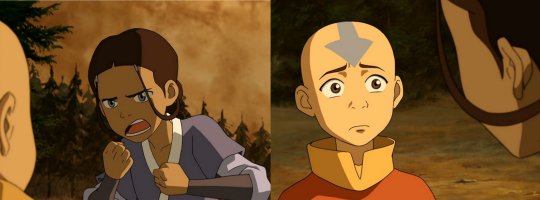
Katara: Will you please shut your air-hole! Believe it or not your infunite wisdom gets a little old sometimes. Why don't we just throw the scroll away since you're so naturally gifted!
Why is Katara that mad here? Why did she have an outburst? Because she was carrying the burden of being the last waterbender of the Southern Water Tribe her whole life. Because her waterbending is the reason Kya died. Because she have been independently studying waterbending her whole life. And now her student is having it all easy and is trying to teach her.
And wouldn't you know it, she realized what she did immediatly. Literally, a second later.
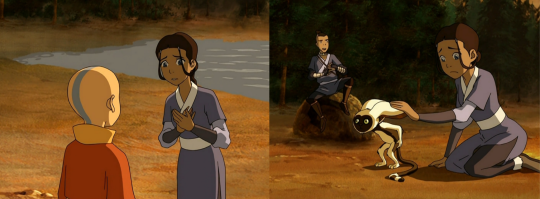
Katara: Oh my gosh Aang. I am so sorry. I don't know what came over me. But you know what, it won't happen again. Here [the scroll] is yours. I don't wanna have anything to do with it anymore.
She even apologized to Momo. Katara had an isecurity rooted in trauma and pressure. When Aang try to teach her she hit a breaking point and lashed out. And not one second later she's already apologizing.
The Waterbending Master
Katara and Aang are going to see Pakku, the waterbending master. But when Pakku sees she's a girl, he says he won't teach her. This is why Katara gets angry. She flew across seas just to get rejected due Pakku is being a sexist freak. I think we can all agree that being denied something because of sexism is a good reason to get angry. And when Katara realized Pakku won't teach Aang if she'll keep insisting, she drops it abd tells Aang to drop it too.
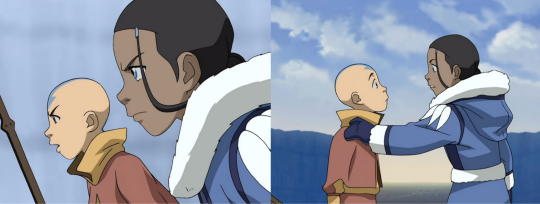
However, that doesn't mean she won't study in secret. She deserved to learn waterbending and she knew it. She took the consequences into consideration and decided to not make a fuss.
But of course, they both get caught. Pakku says he will no longer teach Aang, the Avatar who absolutly needs to study and still refuses to teach Katara because he's still sexist. Only then Katara challenges him to a duel. Only when they have nothing to lose. She challenged a sexist prick to a duel, one who shamelessly denied her oppretunity because of her gender.
The Chase
At the start of the episode Katara gently hints Toph to help unpack a camp for the night. This is when she's not tired yet, and shows patience.
Katara: So Toph, usually when setting up camp, we try to divide up the work.
Toph: Hey, don't worry about me. I'm good to go.
Katara (still calmly): Well, actually, what I'm trying to say is, some of us might fetch water while someone else might set up the fire pit or put up the tent. *smiles* Even Momo does his fair share.
Toph (slightly irritated): Katara, I'm fine. I can carry my own weight. I don't need a fire. I've already collected my own food. And look. *earth bends a tent* My tent's all set up.
Katara: Well, that's great for you but we still need to finish-
Toph (loudly): I don't understand. What's the problem here??
Katara: Never mind.
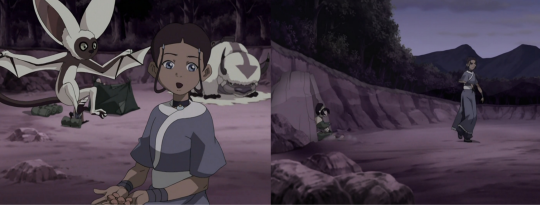
Katara then goes to apologize. While also attempting to make sure her and Toph are on good terms by having her acknoledge that she wasn't 100 absolutly in the right.
Katara: Hey Toph, I wanted to apologize for earlier. I think we're all just a little tired and getting on each other's nerves.
Toph: Yeah, you do seem pretty tired.
Katara (slightly irrutated): I meant all of us.
Toph: Well, good night.
Katara: Good night.

By all means, Toph is in the wrong for the sheer refusal for communication. At first Katara calmly explained to her what was needed without even spelling it out. Toph was being passive, so she dropped it. And then she apologizes after doing nothing wrong just so they could be on good terms. Toph was the one being passive agressive. And Katara pretty much let it slide.
This is Katara. The patience she showed right here is her natural, normal self. The rest of the episode is under the context of sleep deprivation and how it's making them all hostile to each other. Including the pacifist Aang. Who's outburst leads Toph to leave. After she does, both Aang and Katara express remorse.
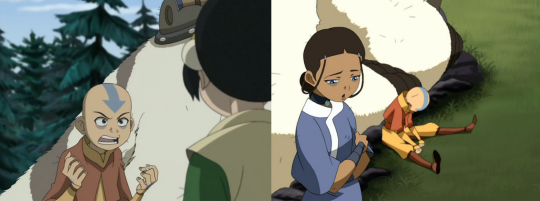
(Side note: I heard people take issue with the line "The stars sure are beautiful tonight, too bad you can't see them, Toph". It's been interpreted as Katara making fun of Toph for being blind, but it's just another instance in the recurring joke of the Gaang forgetting Toph is blind, and listed as such in the official A:TLA Youtube channel).
The Runaway
Update: This section, especially, is majorly outdated.
The episode has a silly opening where Aang is trained by Toph and Katara. Toph misses and accidently hits Katara with a big rock. After Toph doesn't apologize, it leads into a fight which is absolutly not to be taken seriously, that ends with Aang pointing out that it was supposed to be training.

It doesn't work as an exapmle for supposed hot-headedness because the reason this whole thing started because Toph hit Katara with a rock and refused to apologize.
But moving on to the real conflict of these episode, Toph scammed someone and Katara makes it clear that they shouldn't do it again, it'll draw attention to them. Aang promises her it won't happen again but.. um.. you know what happened.
Katara, being responsible, told them to quit because they'd potentially get exposed. Toph didn't reach well, telling her to lighten up. Katara rightfully gets angry, because they really might get exposed and Toph is dismissing her like her concerns are nothing. They have a short argument and Toph storms out.

This is why Katara was angry this episode. Her reasoning for being upset is the Gaang potentially exposing themselves for easy money. That's the conflict.
The Painted Lady
In this episode Katara sees a starving Fire Nation village but Sokka won't allow them to stay due to time limits. So she faked a disease for Appa so they could. Sokka confronts her. At first, she gives up and packs to leave. But since she destroyed the factory that's been polluting the villages water and taking their medicine, the people in charge assumed it was the civilians, and were coming to attack. Sokka and Katara get into a small but intense argument. Important to note, that she doesn't react intensively until Sokka does.
Katara: Well, what was I supposed to do?
Sokka: Leave! Do nothing.
Katara: No! I will never, ever turn my back on people who need me.

Her anger here doesn't highlight hot-headedness, it highlights compassion. Compassion is one of Katara's core traits. She's angry because she's being angrily demanded to see people suffer and stand by. And she will not tolerate it. She will never, ever turn her back on people who need her.
2. In reality, Katara is defined by her patience and compassion.
What I did here was listing off times where Katara did get angry. But Katara is generally a caring, kind person. Rather if it's cheering up Sokka, going shopping with him after he admitted to feeling useless; if it's pulling Aang out of the Avatar state, putting herself at risk when he's out of control; if it's helping deliver a baby of a stranger; or if it's freeing prisoners of the Fire Nation. She demonstrates impressive patience throughout the show.
The Deserter
In this episode Aang was asked to just control fire. Aang gets irrutated himself at this, but Katara assured him that it's probably for a good reaso. But when his master left, he firebent. He was being extremely careless with his new found Fire Bending and burned Katara's hands.
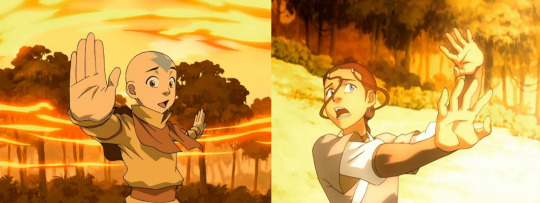
Did she...
A. splashed some water at him.
B. Yelled at him.
C. Ran away crying.
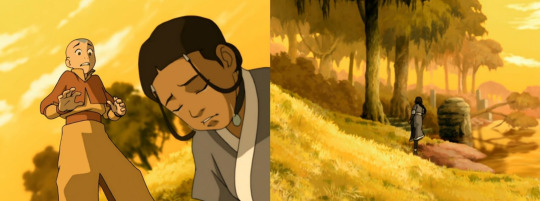
Yeah, she didn't express anger at all. Sokka was who's angry at Aang.
The Desert
The sand benders stole Appa and the Gaang is suck in a desert. Katara demonstrates her patience a lot this episode.
Toph and Aang are arguing about Toph not stopping them.
Aang: You just didn't care! You never liked Appa! You wanted him gone.
Katara: Aang, stop it. You know Toph did all she could. She saved our lives.
Sokka: Who's gonna save our lives now? We'll never make itout of here.
Aang: That's all any of you guys care about, yourselves. You don't care whether Appa is okay or not.
Katara: We're all concerned, but we can't afford to be fighting now.

Aang accused the Gaang of something horrible. Katara told him to stop, but still understood his anger and calmly explained to him that it's important not to fight in a life threatening situation.
Aang then storms out to look for Appa. Katara's response?

Katara: We'd better start walking. We're the only people who know about the solar eclipse. We have to get that information to Ba Sing Se.
She didn't get angry, she was rational and thought about the greater good.
After Aang comes back, Katara suggest they should try sleeping, gives the Gaang all of her bending water without drinking herself. And then finds a way to get to Ba Sing Se using the locations of star systems.
The Gaang spots a cloud and mistakes it for Appa. But Katara realizes the potential in a cloud. She tells Aang to fly and bend the water from the cloud so they could drink.
Katara (disappoibted): Wow, there's hardly any in here.
Aang (intensively): I'm sorry, okay? It's a desert cloud, I did all I could. What's anyone else doing? *Points at Katara* What are you doing?

After dealing with everyone's tireness, Sokka's high nonsense and Aang's attitude, carrying everyone, thinking of possible solutions to ensure they'd all survive, how did she react to Aang accusing her of not doing enough?
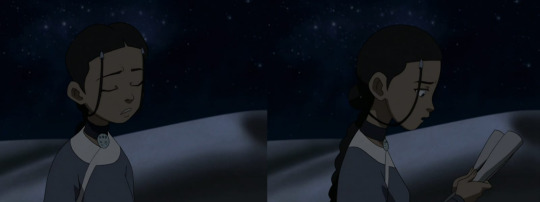
Katara: Trying to keep everyone together. Let's just get moving. We need to head this direction.
And after everything she did for everyone, she pulls Aang out of the Avatar state when he's raging, out of control.
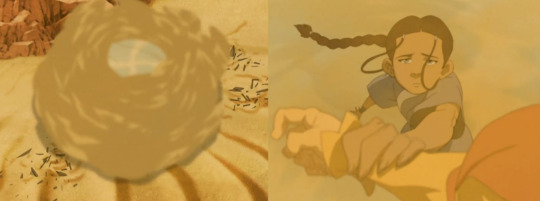
Katara is not so hot headed.
She's sweet, nurturing and caring. She demonstrated incredible patience and perhaps even saved the Gang's life in The Desert with her resilience. Katara's compassion is her defining trait.
But that doesn't mean she's not a human being – she's allowed to be flawed, and in the moments where she does, she's very remorseful. And in the moments where she doesn't, people will still hold her accoutable for simply feeling a justified emotion.
Does it make you oh-so-hot headed to stand up to a sexist denying her opportunity? To make sure your friends don't destroy your chances to win a war? To not tolerate being told to see people in need and do nothing in a middle if an argument she didn't start? Of course it doesn't.
And other characters are allowed to express anger, to be flawed, in ways that are way worse than Katara without being labelled annoying hot headed by the fandom.
Katara is widly known to be irrational, letting her anger get the better of her, but it's simply not true.
#katara of the southern water tribe#avatar katara#atla katara#katara defense#in defense of katara#meta#atla meta#katara meta#atla memes#atla#anti atla fandom#avatar the last airbender katara#avatar the last airbender#katara defense squad#katara deserved better#katara deserves better#the southern water tribe#southern water tribe#avatar the kast airbender meta#toph beifong#toph#long post#the painted lady#the chase#the runaway#the waterbending master#pakku#master pakku#katara and toph#katara my beloved
375 notes
·
View notes
Text


atla and lok controversy memes: my take. no offense to any iroh fans, i just feel like he’s constantly praised for character traits that katara and aang are hated for. other takes include: aang deserves so much better from the fandom & the southern water tribe deserves so much better than what it got from the franchise. also! the ember island players has now become the bane of my existence ever since i read that stupid fucking meta from a self-proclaimed “katara stan” stating that her hypersexualized eip portrayal had Feminist Power (TM) in that very derogratory scene where eip katara is throwing herself at eip zuko. just thinking about it again creeps me out - I’ll definitely finish that meta this weekend.
as for LOK, asami has my whole heart. getting rid of the past lives was the worst decision known to man and a huge fuck you to this franchise that bryke are still suffering from the consequences of (as they should). zaheer is a Reddit incel who read a wiki page and discovered the term anarchy for the first time. he has completely bastardized everything that the air nomads stands for and i hate seeing people say that he’s a powerful airbender by any means. bolin is literally the most overrated character in the entire franchise and his relationship with opal is just terrible. justice for opal. this is also fuelled by the fact that i saw several people state that bopal is better written than kataang and korrasami.
rants aside, feel free to reblog this with your own version of the controversial meme!


17 notes
·
View notes
Note
Five more headcanons for the “you had ONE JOB” where Aang has to deal with a Zuko that can fly after him?
Continued from: [Link], [Link], [Link], [Link], [Link], [Link], [Link], [Link], [Link], and [Link].
1. I've got a whole meta about how the first three episodes of Book One structure Zuko and the Fire Nation's introduction as threats, how the first two set up Zuko as the principle antagonist, and we as the audience are led to believe that we will be having a fun little romp with lots of screwball shenanigans as the characters run into and have to outwit Zuko, and how the third episode blows this out of the water, by showing that Zuko is a pretty minor threat compared to the rest of the Fire Nation, and nothing about this is going to be a fun low stakes romp: [Link]. The problem is, for this AU, as far as pretty much everybody's concerned, Zuko is a legend and just about the biggest thing the Fire Nation can throw at anybody. But he's not actually tougher or smarter than Zuko in canon, except in that he has war balloons, and the trust of the Fire Nation military, minus Zhao. It's only that in this AU, he's the child of Ozai's, who was born lucky. What's going to happen now that he's hunting the Avatar and that luck runs out?
2. The Southern Water Tribe is remote and isolated, but not so isolated that they haven't heard tales of the demon Fire Nation prince who learned to fly, who conquered Omashu and Ba Sing Se. And Sokka and Katara make it very clear to Aang just who is chasing them, chasing him, and how much he needs to be afraid. Which means that when Aang in the Avatar State knocks Zuko's ship careening into an iceberg, it's hard for the three not to feel pretty confident.
3. But Zuko owes his recent successes to many things, only one of which is luck. He is still determined and clever, and he has the trust of the Fire Nation military. And, he has spent the last 3 years feeding on a steady diet of success, rather than humiliation and rejection. He does not react to the gangs beating him with laughable anger and mortification, which only makes it worse, as I describe here: [Link]. Instead he reacts with his determination, and settles in for the long haul. All this means that when he runs into Zhao, it's harder for Zhao to goad him into a fight. And when he does fight Zhao and win, it's not one success out of a string of failures and humiliations, but a footnote to him. And Zhao isn't seen as pathetic for losing to a sixteen year old, rather instead, he is seen as an idiot and a fool for challenging a living legend. Meanwhile, Aang is off learning just how terrible Fire Nation victory can be in the Southern Air Temple.
4. And of course on Kyoshi Island, Zuko learns that he can fight a village no problem, but even war balloons are no match for an unagi.
5. This is all a very fancy way of saying that at first, there is very little different about this world from canon, but the way everybody perceives these events is different. That doesn't change until the gaang finds themselves in the vicinity of Omashu. They sneak into the city so Aang can show Sokka and Katara the mail carts. But while they're there, they hear rumors of the city's erstwhile king being held captive in a metal box, a king named Bumi.
#avatar the last airbender#zuko#katara#sokka#Aang#posts i created#do you want to ask a question it doesn't have to be a question#zuko is a dweeby little turtleduck#katara is the answer#sokka the meat and sarchasm guy#aang d'awww#five headcanons
29 notes
·
View notes
Note
in regards to the hama ask, imo as a native person, I don't think it's wrong hama got punished. thats kind of a hot take, but my issue comes with how she was punished and that we never saw anything more. katara was right to not want to continue the cycle of revenge, just like hama wasn't bad for wanting revenge. personally i don't have a problem with what she did lol BUT i also think people refuse to acknowledge native people can be bad and angry and want revenge even if it takes form in horrible ways. hama should be a lesson on what happens when your nation do these things- she shouldn't get away with it, but keeping her in the fire nation defeats the purpose of what she's meant to show. someone so blinded by hatred they don't really care about ending the war or their own people, just hurting the people who hurt them. but you can't expect someone who became this way to see the wrong in hurting people by keeping them in the prison that kickstarted their desire for revenge. idk if this is worded right but I don't think hama being punished is inherently bad and I get annoyed when people say she didn't do anything wrong bc yes she did! and that's great! it just could've been handled better in the aftermath
Thank you for sending anon! Yes everything you said was basically the meta I read that I couldn’t find. UPDATE: I found the meta
I agree hama going back to the fire nation prison was really the only part I personally disagreed with. Putting Hama back in the situation that caused her to become to so angry and vengeful seemed to defeat the whole narrative of the episode which is Katara’s right to not want to continue the cycle of vengeance because Hama is right back where she started. Also logistically if Hama broke out of prison once what’s to stop from her doing it again? lol
Like I said, I did read that Hama (along with any water tribe/earth kingdom was prisoners) was sent home so that’s good. I think an interesting story would be Hama’s return home and how the Southern Water Tribe would decide how to deal with her as a threat.

Not that Hama would hate her tribe but as a community full of nonbenders especially if there are any persons like Sokka who seems to actually hate her, there could be those who don’t trust someone with that kind of power. This could lead to the issue of nonbenders vs benders because even tho Katara didn’t agree with Hama, she can understand what having that power feels like and maybe advocates Hama’s rehabilitation. And then how would the tribe react to hearing about this ability? Would it make them treat benders like Katara differently? Would they sympathize with Hama or trust her to re-integrate back into society? So many avenues to explore
5 notes
·
View notes
Text
I know we’ve all spent a lot of time positing what the Southern Water Tribe’s betrothal item(s) would be. This is my take on it.
Rewatching ATLA, I’ve noticed that Katara starts wearing her hair down once they reach the Fire Nation. I’m sure there are any number of explanations for it. I myself first thought, “Oh, well, she’s just trying to fit in with Fire Nation folk.” But then I thought of Ty Lee and her braid and that started me off down this headcanon I’ve developed regarding Katara’s hair.
My theory is that braids are for young girls in the Southern Water Tribe. Girls who haven’t reached the age of majority. But when they reach the age of majority, they wear their hair half up, the way Katara does. In my mind, the age of majority for girls in the Southern Water Tribe is fifteen. Which would mean (in my own personal headcanon) that Katara is fifteen by the end of the war. This also makes sense if you believe that most waterbenders are born in winter. If the seasons and hemispheres in the world of ATLA work the way ours do, then the fact that they’re in the Fire Nation by summer would mean that Katara has turned fifteen because it is winter in the South Pole. Thus, Katara wearing her hair half up (as she does for the remainder of the series) means that she has reached the age of majority in the Southern Water Tribe!
I then theorize that women in the Southern Water Tribe wear their hair this way until they settle on the person they want to marry. When they’ve decided, they then wear their hair in some kind of updo as a signal to their tribe and that person. If that person reciprocates, they present her with a set of beads for her to wear in her new hairstyle. This makes the process of getting engaged in the Southern Water Tribe one of much more equal footing that the tradition of betrothal necklaces in the Northern Water Tribe.
Following that, women wear their hair up for as long as they are married. Nobody aside from their S.O. and children is ever supposed to see them with their hair down again as it’s considered too intimate.
#atla meta#meta#katara meta#katara#southern water tribe#southern water tribe meta#posted this meta as part of an ask game#but I just really wanted to share it with everyone#it's my favorite meta or headcanon or whatever you want to call it#headcanon#atla headcanons#headcanons#katara headcanon
211 notes
·
View notes
Text
Avatar: The Last Airbender Ethnicities:
I've noticed a few people have made modern headcanons based off of the ATLA characters' races & ethnicities, and a lot of them were very inaccurate based off of canon; so I'm going to explain which countries and cultures each of the four nations are based on.
The Air Nomads:
The Nomads' culture closely resembles mostly to that of Tibetan Monks and to Hindu priests to some degree. Their bald heads, clothing and meditation practices are very similar to those of real life Buddhist monks. The nomads practice vegetarianism like many real life Hindus and Buddhists. The method the monks used to find the Avatar, such as having toys for the child to choose from, is also the same method Tibetans used to find the Dalai Lama. Air temple architecture draws from real life Chinese Buddhist Pagodas. Aang’s mentor was named Monk Gyatso and Aang’s son, was named Tenzin, which form the real name of Tibet’s 14th and current Dalai Lama, Tenzin Gyatso.
Many airbenders wear saffron robes based off of those of Shaolin monks. The outfit Aang wears in season three is similar to that of the Dalai Lama.
The erratic and free style of air bending is based on ancient Chinese martial art of Ba Gua.
As for their architecture, it strongly resembles Pagoda Forest of China and Taktsang Temple of Bhutan (a Southern Asian country).
Their history also has a lot of real-world relevance, as the Air Nomad Genocide by Fire Nation is based off of an actual historical event, the Annexation of Tibet by the People's Republic of China.
Therefore, the closest ethnic group to the Air Nomads would be the Tibetan people, with a lot of Chinese influence.
Earth Kingdom:
The Earth Kingdom is the most diverse region of the Avatar world. Their architecture is almost soley influenced by those of China, but they also shares similar cuisine with China, such as roast duck and jook. Much of the clothing is based on the clothing of pre-manchu China, with the exception of Ba Sing Se, which is based on the Qing Dynasty. In addition, Korean clothing, such as hanbok, can be seen being worn by some characters as well. Architecture in the Earth Kingdom is very Chinese influenced in general.
The Earth Kingdom army uniforms resemble ancient Chinese military uniforms, particularly those of the Song and Ming Dynasty. The capital, Ba Sing Se, draws many parallels with ancient Chinese capitals such as Beijing.
Also, Kuei, the 52nd Earth King, resembles the the last emperor of China, Puyi. In appearance, both of them even wears circular glasses; and in culture, both rulers were kept ignorant of the state of their nation and had no real power. Kuei had previously never left the Ba Sing Se palace, akin to how Puyi, up to a point, was always kept in the Forbidden City.
The government also draws a parallel with the authoritarian Ming Dynasty with its propaganda and police state. It takes after China and the communist revolution. For example, Lake Laogai is named after the reeducation camps constructed by Mao Zedong; and the Dai Li is named after the leader of the Chinese Secret Police.
The sand benders in the desert also bear a resemblance to the Tuareg people in Northern Africa.
The strong stances and strikes of earthbending is based on ancient Chinese martial art of Hung Gar, although Toph’s specific style is inspired by Southern Praying Mantis style.
However, despite the Earth Kingdom's mostly Chinese influence, the Kyoshi warriors resemble Kabuki actors and geisha of Japan, and Kyoshi Island seems to hold more similarities to Japan tham China, as well.
Therefore, the people of Ba Sing Se would be Chinese, and since the Kingdom was formed around Ba Sing Se as their Capital, so would the majority of the Earth Kingdom as well. There are two excepts, though, with those who live on Kyoshi Island, who would be mixed of Japanese and Chinese ancestry. Along with that, the sand benders would be Tuareg, as it's the only part of their culture we've seen.
The Fire Nation:
The mainstream Fire Nation culture closely resembles mostly Japan and China to some extent. Their architecture strongly resembles Chinese architecture, and their army wears ancient uniform of Chinese military.
As for their real-world similarities, as previous stated in the Air Nomad's history, their invasion on Air Temples, were quite similar to real life invasion of Tibet by People’s Liberation Army of China.
As for the Fire Nation’s similarities with Japan, they're mostly based off of Imperial Japan. This includes them being an extremely militaristic and industrialized country in only a few decades, and being the expansionist nation compared to others. Their propaganda justifying their imperialism is similar to that of Japan’s propaganda during World War II, as they used to justify their invasion on rest of the S.E. Asia.
The Fire Nation is influenced by other Chinese and Southeast Asian cultures as well. The Fire Nation’s topography is also similar to Japan, Hawaii, and Polynesian Islands. Ancient Egyptian and Chinese architecture inspired the Fire Nation Royal Palace and the royal garden is similar to classical Chinese ones. The Palace is visually similar to the Forbidden City but to a lesser extent. The Fire Temple is based on Chinese pagodas. However, Ember Island draws from Southeast Asian resorts, which can be seen in the numerous paintings and vases in the homes.
Chinese influences can be seen in Fire Nation attire. In particular, Zuko can be seen wearing a shenyi, a historical Chinese clothing.
Warlord era of the Fire Islands (an era before Fire Lord uniting the islands into single nation) were based on the Ainu culture of Japan and Russia.
The Sun Warriors were known for worshipping the sun since they drew their power from it, similar to Mayan and Aztec cultures, who also glorified the sun. Their clothing is very similar to traditional Southeast Asian warrior dress, most notably, their headdresses. Sun Warriors’ buildings are reminiscent of Mesopotamian and Southeast Asian architecture, such as the Phanom Rung and Angkor Wat.
Therefore, the Fire Nation's people could be seen as either Chinese or Japanese, as both of their culture is very prevalent. Due to the Earth Kingdom's people already being based off of China, I personally see the Fire Nation as Japanese. However, as previously stated, the Sun Warriors are mostly likely a mixture of Japanese and Southern Asian Indigenous descent.
The Water Tribe:
As seen on maps in ATLA, the north and south Water Tribes are positioned on the coldest extremes, similar to the real life tribe of the Inuit, who are a nation of many communities in Arctic & Subarctic regions in Russia, the US, Canada, & Greenland.
As for cultural similarities, Katara and other women in the Southern Water Tribe are seen wearing hair loops, which are actually hairstyles worn by Inuit women. There are also igluvijait (snow houses) in Katara and Sokka’s Southern Water Tribe village, and iglu/igluit means any kind of house in many Canadian Inuktitut dialects. Water Tribe members are also seen wearing anorak clothing, which was originally worn by the indigenous peoples of the Arctic designed to keep them warm and protected from harsh weather.
Their fighting style is based off of Chinese Tai-Chi. The Australian Aboriginals' weapons, such as the boomerang, can be seen being used by Water Tribe warriors, most notably Sokka. Face Paint, as seen being wore by the Water Tribe members, is also more common among Native American tribes; whereas tattoos are more common in Inuit culture. Water Tribe ships resemble Polynesian catamarans.
Different cultures inspired Water Tribe architecture based on their geography. The Northern Water Tribe’s architecture pulls from the ancient Aztecs’ pyramids and Venice’s canal systems while the Southern Tribe’s igloos mirror those of the Inuit.
Native American, Chinese and Japanese myths even influenced Water Tribe spiritual practices. For example, the moon and ocean spirits, Tui and La, are reminiscent of the Chinese legend of Yin and Yang.
For real-world similarities, Avatar has used modern disputes; such as the conflict over oil and ‘progress’ in the the graphic novel Avatar: The Last Airbender—North and South has been taken straight from conflicts in Inuit territory in Alaska.
Therefore, it makes sense to have both of the tribes be mostly made up of Inuit people. I personally view the Southern Water Tribe as being Inuit, and the Northen Tribe as being a Yup'ik due to the mixed influences.
Reminder: This is all based off of my own personal research, along with what other people have noticed as well, and my opinions because of it. My purpose for making this was to avoid white-washing that happens in the fandom, and to hopefully help educate others. If any information is wrong, feel free to correct it!
#avatar the last airbender#avatar#atla#atla meta#atla analysis#fire nation#air nomads#earth kingdom#ba sing se#northern water tribe#southern water tribe#water tribe#earth bender#water bender#fire bender#air bender#katara#aang#sokka#toph#zuko#toph beifong#aloeverants
161 notes
·
View notes